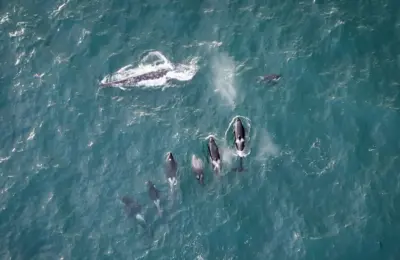Article: Franco, JN, T. Wernberg, I. Bertocci, P. Duarte, D. Jacinto, N. Vasco-Rodrigues, and F. Tuya. 2015. Herbivory drives kelp recruits into ‘hiding’ in a warm ocean climate. Marine Ecology Progress Series, 536(1-9), DOI: 10.3354/meps11445
Background
Kelps are a type of large brown algae that can grow to impressive sizes of over 200 feet (80 meters) tall! While kelps are not technically plants, they serve as underwater trees, creating dense kelp forests in relatively shallow coastal areas (Figure 1). Kelps prefer cool, nutrient rich waters with lots of access to sunlight to support their rapid growth.


Kelp forests are the cold water equivalent of tropical coral reefs. The photosynthesizing kelps serve as the base of the food web and create lots of energy from sunlight that can be harvested by herbivorous (plant-eating) invertebrates and fishes. The physical structure of the kelps, much like coral reefs, provides shelter for smaller fishes, resulting in a highly productive, diverse, and well-balanced ecosystem.
Both fish and invertebrates, particularly sea urchins, graze on kelps. At times, populations of kelp predators can increase to the point that they can turn kelp forests (Figure 1) into urchin barrens (Figure 2), which lack the productivity and biodiversity of kelp forest ecosystems.
Study Objectives and Methods
This study investigated how temperature, geography, and abundance of kelp-eating predators all affect where kelp can be found and the abundance of kelp in these areas. The study took place along the coast of Portugal, which is a transition zone from warmer waters to cooler waters. Two regions were compared in this study: Vila do Conde in the north, and Peniche in central Portugal. The water in central Portugal averages 1oC (1.8oF) warmer than the water in northern Portugal throughout the year. The authors also compared two different types of geography in each region – open reefs and crevices – to determine if kelps are found more often in a particular type of bottom habitat.
The researchers measured the abundance of kelp and kelp-eating predators by swimming along straight lines called transects of predetermined lengths and counting all of the kelps or kelp-eating predators within a certain distance of those transects. This process was repeated at several sites in both the central and northern regions.
Next, to measure the survival rate of kelps in each region, the researchers tagged 20 individuals at each site with cable ties and came back to recount them after one month.
Finally, the researchers measured the amount of kelp eaten by removing and weighing groups of six kelps. Then, once weighed, the kelps were placed back on the bottom by attaching them to chains. These kelps were recollected and reweighed after 32 days to measure the amount of kelp eaten over that time. They also collected and photographed 134 kelps to examine the bite marks present. This helped the researchers determine the portion of kelps that had visible bite marks, and what type of predators (fish or urchins) had been feeding on them.
Results

All signs point to tough times for kelps in warmer waters. There were 3.9 times as many kelps in the cooler northern region (Vila do Conde) than in the warmer central region (Peniche) (Figure 3). Most notably, of the few kelps found in the warmer region, 87% of them were found tucked into crevices where they were at least partially hidden from predators. On the other hand, 85% of kelps found in the cooler northern region were found in open reefs where the kelps have better access to sunlight and can better serve as habitat for other inhabitants of the ecosystem.
The warmer central region was found to have a whopping 140 times as many sea urchins and 45 times as many kelp-eating fish than the northern region! Therefore, it wasn’t surprising to find that the kelps in the central region had substantially more grazing marks (Figure 4) and lost much more tissue from consumption over the 32 days.


Significance

In warmer waters that have lots of kelp-eating predators, kelps are almost only found hidden within crevices. This means that these organisms require this sort of crevice structure to survive predation because the predators cannot fit within the narrow crevices (see Figure 6 for an example of kelp-eating fish). Therefore, areas of ocean that do not have crevices that can protect kelps will not be able to harbor these valuable. Furthermore, when kelps are surviving only by hiding within crevices they are not providing the structural habitat for other fishes or serving the ecological functions that they normally would.
Arguably, the most important consequence of this study is its relation to global climate change. As the Atlantic Ocean warms, more northern regions of ocean begin to match current southern regions in . Scientists have seen a variety of organisms begin to live farther north than decades past because warmer temperatures in the northern regions now allow them to inhabit the area. This study shows that even a 1oC increase in temperature in the northern kelp forests could allow sea urchin and fish predators to move into this region, with potentially devastating effects on the kelp forests there.
Do you think that global climate change will have a negative impact on kelp forests in the Atlantic? Why or why not? Comment below!
Derrick is pursuing a Ph.D. in the Organismic and Evolutionary Biology Program at the University of Massachusetts Amherst. He is interested in anadromous fish migrations, how aquatic organisms interact with their physical environment, and the impact of human development on natural systems.

